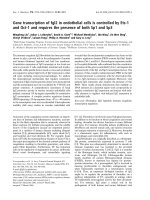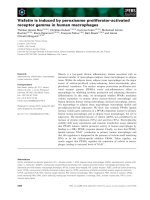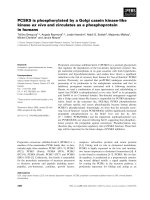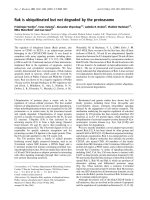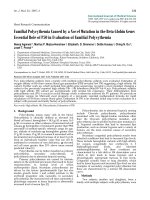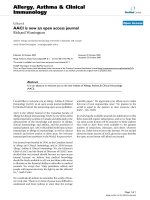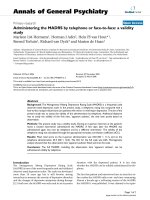Báo cáo y học: "CXCL12 is displayed by rheumatoid endothelial cells through its basic amino-terminal motif on heparan sulfate proteoglycans" ppsx
Bạn đang xem bản rút gọn của tài liệu. Xem và tải ngay bản đầy đủ của tài liệu tại đây (579.27 KB, 8 trang )
Open Access
Available online />Page 1 of 8
(page number not for citation purposes)
Vol 8 No 2
Research article
CXCL12 is displayed by rheumatoid endothelial cells through its
basic amino-terminal motif on heparan sulfate proteoglycans
Begoña Santiago
1
, Françoise Baleux
2
, Guillermo Palao
1
, Irene Gutiérrez-Cañas
1
, Juan C Ramírez
1
,
Fernando Arenzana-Seisdedos
3
and José L Pablos
1
1
Servicio de Reumatología y Unidad de Investigación, Hospital 12 de Octubre, Avda. de Córdoba s/n, 28041 Madrid, Spain
2
Organic Chemistry Unit, Pasteur Institute, 28 Rue Dr. Roux, 75724 Paris CEDEX, France
3
Viral Immunology Unit, Pasteur Institute, 28 Rue Dr. Roux, 75724 Paris CEDEX, France
Corresponding author: José L Pablos,
Received: 7 Sep 2005 Revisions requested: 20 Oct 2005 Revisions received: 9 Jan 2006 Accepted: 17 Jan 2006 Published: 3 Feb 2006
Arthritis Research & Therapy 2006, 8:R43 (doi:10.1186/ar1900)
This article is online at: />© 2006 Santiago et al.; licensee BioMed Central Ltd.
This is an open access article distributed under the terms of the Creative Commons Attribution License ( />),
which permits unrestricted use, distribution, and reproduction in any medium, provided the original work is properly cited.
Abstract
The chemokine CXCL12 (also known as stromal cell-derived
factor, SDF-1) is constitutively expressed by stromal resident
cells and is involved in the homeostatic and inflammatory traffic
of leukocytes. Binding of CXCL12 to glycosaminoglycans on
endothelial cells (ECs) is supposed to be relevant to the
regulation of leukocyte diapedesis and neoangiogenesis during
inflammatory responses. To improve our understanding of the
relevance of this process to rheumatoid arthritis (RA), we have
studied the mechanisms of presentation of exogenous CXCL12
by cultured RA ECs. RA synovial tissues had higher levels of
CXCL12 on the endothelium than osteoarthritis (OA) tissues; in
both, CXCL12 colocalized to heparan sulfate proteoglycans
(HSPGs) and high endothelial venules. In cultured RA ECs,
exogenous CXCL12α was able to bind in a CXCR4-
independent manner to surface HSPGs. Desulfation of RA EC
HSPGs by pretreatment with sodium chlorate, or by replacing in
a synthetic CXCL12α the residues Lys24 and Lys27 by Ser
(CXCL12α-K2427S), decreased or abrogated the ability of the
chemokine to bind to RA ECs. Ex vivo, synovial ECs from
patients with either OA or RA displayed a higher CXCL12-
binding capacity than human umbilical vein ECs (HUVECs), and
in HUVECs the binding of CXCL12 was increased on exposure
to tumor necrosis factor-α or lymphotoxin-α
1
β
2
. Our findings
indicate that CXCL12 binds to HSPGs on ECs of RA synovium.
The phenomenon relates to the interaction of HSPGs with a
CXCL12 domain with net positive surface charge located in the
first β strand, which encompasses a canonical BXBB HSPG-
binding motif. Furthermore, we show that the attachment of
CXCL12 to HSPGs is upregulated by inflammatory cytokines.
Both the upregulation of a constitutive chemokine during
chronic inflammation and the HSPG-dependent immobilization
of CXCL12 in EC surfaces are potential sites for therapeutic
intervention.
Introduction
Chemokines are a large family of soluble proteins involved in
leukocyte activation and traffic during inflammatory responses.
Chemokines signal through G-protein-coupled receptors [1].
In vivo, chemokine-dependent directional migration of leuko-
cytes is supposed to require the immobilization of chemokines
either to the extracellular matrix or to cell surfaces. Chemok-
ines induce cell-matrix or cell-cell adhesion through the activa-
tion of integrins, and studies in vivo demonstrate that the
presence of chemokines immobilized on the luminal side of
endothelium is a critical step for firm adhesion and transend-
othelial migration of rolling leukocytes [2-6]. This phenomenon
can be reproduced in vitro in cultured endothelial cells (ECs)
and depends on the addition of exogenous chemokines and
the presence of fluid shear-induced mechanical stress on leu-
kocytes [5,6]. Endothelial cells secrete a limited number of
chemokines, suggesting that many of the homeostatic or
inflammatory chemokines presented at the EC surface come
from other cell sources by transcytosis and docking of chem-
okines on the EC luminal surface [7-9].
EC = endothelial cell; FCS = fetal calf serum; FITC = fluorescein isothiocyanate; HEV = high endothelial venule; HSPG = heparan sulfate proteogly-
can; HUVEC = human umbilical vein EC; LT-α
1
β
2
= lymphotoxin α
1
β
2
; mAb = monoclonal antibody; OA = osteoarthritis; RA = rheumatoid arthritis;
RT-PCR = reverse transcriptase polymerase chain reaction; TNF-α = tumor necrosis factor-α.
Arthritis Research & Therapy Vol 8 No 2 Santiago et al.
Page 2 of 8
(page number not for citation purposes)
CXCL12 (also known as stromal cell-derived factor, SDF-1) is
the unique identified natural ligand of the G-protein-coupled
receptor CXCR4 and exhibits both homeostatic and proin-
flammatory functions in humans. The main cellular sources of
CXCL12 are resident stromal fibroblasts and epithelial cells.
CXCL12 participates in the homeostatic traffic of hematopoi-
etic cells and lymphocytes. Indeed, CXCL12 is constitutively
displayed by endothelial cells (ECs) in the bone marrow and
secondary lymphoid organs, where it seems to be produced
by nearby osteoblasts, stromal cells, or tonsil epithelium [10-
12]. The CXCL12/CXCR4 axis also participates in the recruit-
ment of inflammatory cells as shown in animal models of aller-
gic airway disease and rheumatoid arthritis (RA) [13-15].
CXCL12 is constitutively expressed by synovial fibroblasts
and lung epithelium and is not a cytokine-inducible factor. The
mechanisms that induce the upregulation of CXCL12-medi-
ated leukocyte recruitment in these models therefore remain
unclear [15,16]. In this regard, blocking CXCR4 by non-pep-
tidic antagonists has been an effective anti-inflammatory ther-
apy in both asthma and arthritis models [13-15]. In RA and
lymph nodes, CXCL12 mRNA is expressed by perivascular
stromal cells but not by endothelial cells [11,16]. Our previous
studies have shown that CXCL12 protein is specifically immu-
nodetected in RA endothelium, in sharp contrast with normal
synovial vessels [16]. The presence of cell-surface immobi-
lized CXCL12 in endotheliawas sensitive to heparitinase,
which selectively degrades the glycosaminoglycan moiety
(heparan sulfate) in heparan sulfate proteoglycans (HSPGs).
These findings suggest that the presence of CXCL12 immobi-
lized in ECs, in the lumen of vessels, is enhanced under inflam-
matory conditions. Potential mechanisms are either increased
secretion or increased transport and docking of perivascular
CXCL12 to the luminal side of ECs. Previous reports showed
that, in vitro, CXCL12 specifically binds heparan sulfates
through a domain with net positive surface charge located in
its first β strand, which encompasses a canonical BXBB
HSPG-binding motif [17-19]. The sensitivity of EC-bound
CXCL12 to heparitinase in RA is compatible with cell-surface
attachment of the chemokine by a HSPG-dependent mecha-
nism.
We have analyzed the mechanisms of interaction between
exogenous CXCL12 and ECs obtained from synovial tissues,
and here we show that CXCL12 binds to membrane HSPGs
in cultured RA ECs independently of its CXCR4 receptor.
Importantly, the amount of immobilized CXCL12 was upregu-
lated by tumor necrosis factor (TNF)-α or lymphotoxin α
1
β
2
(LT-α
1
β
2
) treatment in non-synovial ECs, suggesting that the
presentation of CXCL12 on ECs can be upregulated at the
EC level, independently of its degree of expression. Further-
more, the immobilization of CXCL12 on RA EC surfaces is
explained by the selective interaction of sulphated HSPGs and
no other proteoglycans. This interaction relies on the integrity
of a positively charged amino acid cluster located in the first
sheet of the CXCL12 β strand, which forms the canonical
binding motif for HSPG.
Materials and methods
Biotinylated CXCL12α was synthesized by the Merrifield
solid-phase method on a fully automated peptide synthesizer
using Fmoc (N-(9-fluorenyl)methoxycarbonyl) chemistry as
described previously [17,18]. Selective biotinylation at the
carboxy-terminal position was achieved by incorporating a
lysine residue (Lys68) bearing a 4,4-dimethyl-2,6-dioxocy-
clohex-1-ethylidene (Dde) protective group on the side chain.
Coupling of biotin was performed on the peptide resin after
Dde deprotection. Non-biotinylated native CXCL12α or 2/6
CXCL12α, in which the basic residues Lys24 and Lys27 were
replaced by Ser (CXCL12α-K2427S), were synthesized simi-
larly.
Synovial EC cultures were obtained from enzymatic cell sus-
pensions of three RA and four osteoarthritis (OA) synovial tis-
sues obtained at the time of joint replacement surgery. All
patients gave informed consent, and the study was approved
by the ethics committee of the Hospital 12 de Octubre. ECs
were purified by two rounds of immunomagnetic enrichment
with anti-CD105 coupled to magnetic beads (Miltenyi Bio-
tech, Bergisch Gladbach, Germany). ECs were cultured in
medium199 (Life Technologies, Paisley, Renfrewshire, Scot-
land) with 10% FCS and the endothelial identity of cultured
cells was confirmed by flow cytometry with UEA-rhodamine
and anti-P1H12 antibodies (Chemicon, Temecula, CA, USA).
Human umbilical vein ECs (HUVECs) were prepared from
umbilical cord by digestion with collagenase and were propa-
gated in medium199 with 20% FCS. Cultures displaying more
than 90% cells positive for both EC markers were used
between the third and seventh passages.
Cultured ECs were exposed to 300 to 1,000 nM CXCL12α
peptides for 90 minutes in PBS buffer at 4°C and washed
extensively in PBS. Surface presentation of exogenous
CXCL12α was analysed by flow cytometry with K15C mAb
and fluorescein isothiocyanate (FITC)-labelled secondary anti-
body or, in the case of biotinylated CXCL12α, with avidin-FITC
(Pharmingen, San Diego, CA, USA). Expression of HSPGs in
cultured ECs was studied with 10E4 anti-heparan sulfate-
FITC mAb (Calbiochem, San Diego, CA, USA). Expression of
CXCR4 in cultured ECs was studied with 12G5 mAb
(Pharmingen) in 0.5% Tween 20 permeabilized or non-perme-
abilized ECs.
Where indicated, 500 µg/ml sodium heparin (Rovi S.A.,
Madrid, Spain) or 50 µg/ml T134 (a CXCR4 inhibitor) was
added to the CXCL12α incubation medium. T134 specifically
prevents the binding of CXCL12 to CXCR4 receptor at pico-
molar concentrations [20]. Pretreatment of EC cultures with
60 mM sodium chlorate was performed for 24 hours before
CXCL12α binding. Removal of surface HSPGs in cultured
Available online />Page 3 of 8
(page number not for citation purposes)
cells was performed by treatment with a cocktail of 100 mU/
ml heparitinases I, II and III each, or 100 mU/ml chondroitin sul-
fate ABC lyase as a control for 90 minutes at 37°C (Sigma
Aldrich Química S.A., Madrid, Spain). Where indicated, EC
cultures were stimulated with either 25 ng/ml TNF-α or 10 ng/
ml LT-α1/β2 (R&D Systems, Inc., Abingdon, Oxon, UK) for 16
hours before CXCL12α binding.
CXCL12 expression by ECs was studied by RT-PCR on
cDNA synthesized from 1 µg of total RNA with the use of the
CXCL12 oligonucleotides 5' -TCTGAGAGCTCGCTT-
GAGTG-3' (upstream) and 5' -GTGGATCGCATCTAT-
GCATG-3' (downstream) and the β-actin oligonucleotides 5' -
CTACCTCATGAAGATCCTCAC-3' (upstream) and 5' -GTC-
CACGTCACACTTCATGATG-3' (downstream). As a positive
control for CXCL12 expression we used cDNA from RA syn-
ovial fibroblasts.
For immunolabelling of synovial tissues from patients with RA
and control patients with OA, tissues were snap-frozen in opti-
mal cutting temperature (OCT) compound and stored at -
80°C. Double labelling for HSPGs and CXCL12, or MECA-79
and CXCL12, was performed as described previously [16,21].
Flow cytometry data were expressed as mean fluorescence
intensity (mean ± SD), normalized by the mean fluorescence
intensity of the negative control. Statistical analysis was per-
formed with Student's t test.
Results
HSPGs and CXCL12 are immunodetected in RA vessels
By immunoperoxidase labelling of RA (n = 9) and OA (n = 8)
synovial sections, we found that CXCL12 was abundantly
present on the luminal side of RA sublining vessels (nine of
nine tissues) in contrast to OA vessels, in which it was only
rarely (three of eight tissues) and weakly detected (Figure 1).
HSPGs were detected with a diffuse pattern involving all ves-
sels in both RA and OA sections. Colocalization of HSPGs
and CXCL12 was confirmed in RA vessels, although many
vessels in RA sections and all vessels in most OA sections
lacked CXCL12 despite their clear expression of HSPGs (Fig-
ure 1). In both RA and OA sections, CXCL12 was detected in
lining synoviocytes and scattered fibroblasts in the sublining,
although RA sections showed a higher proportion of labelled
cells and some areas of extracellular matrix labelling.
High endothelial venule (HEV)-like vessels are found in RA
synovium but not in OA synovium and represent specialized
vessels involved in cell recruitment [21]. Because labeling of
RA vessels with CXCL12 seemed to be present in both flat
and HEVs, we studied whether MECA-79-expressing HEVs
also display CXCL12 immunostaining. By double MECA-79
and CXCL12 immunofluorescent labelling, we observed that
MECA-79-positive HEVs preferentially displayed CXCL12
compared with flat MECA-79-negative vessels (Figure 1).
CXCL12α binding to cultured RA ECs
To study the potential interactions between CXCL12α and EC
surface molecules, we analysed the ability of human RA ECs
to present exogenous native or biotinylated CXCL12α on their
surface molecules. Endogenous CXCL12 expression was not
detectable by the K15C mAb in cultured RA ECs. We have
previously shown by in situ hybridization that, in spite of the
positive immunodetection of CXCL12 in RA ECs, these cells
lacked CXCL12 mRNA expression [16]. To confirm the lack of
CXCL12 expression by RA ECs we performed RT-PCR in cul-
tured RA ECs, which yielded negative results in all tested RA
EC cell lines; this was in contrast with synovial fibroblasts, in
which CXCL12 message was detected (data not shown). We
found that after the addition of exogenous native or bioti-
nylated CXCL12α, surface-bound CXCL12α was readily
detected by flow cytometry (Figure 2a). This binding was
unlikely to have been due to CXCR4 binding, as indicated by
Figure 1
Double labelling of CXCL12/HSPGs and CXCL12/MECA-79 of rheu-matoid arthritis (RA) and osteoarthritis (OA) synovial tissuesDouble labelling of CXCL12/HSPGs and CXCL12/MECA-79 of rheu-
matoid arthritis (RA) and osteoarthritis (OA) synovial tissues. Frozen RA
or OA sections were labeled simultaneously with anti-CXCL12 K15C
mAb and fluorescein isothiocyanate (FITC)- conjugated anti-heparan
sulfate proteoglycan (HSPG) mAb (green fluorescence) or MECA-79
mAb (red fluorescence). In CXCL12/HSPG double-labeled sections,
CXCL12 was developed with immunoperoxidase (brown color) and in
CXCL12/MECA-79 double-labeled sections with a secondary FITC-
labeled antibody. Arrows indicate colocalization of CXCL12 to HSPG-
labeled RA vessels. The same section, sequentially photographed
under appropriate optics, is shown in parallel left and right panels. Orig-
inal magnification × 400.
Arthritis Research & Therapy Vol 8 No 2 Santiago et al.
Page 4 of 8
(page number not for citation purposes)
the following lines of evidence. In cultured RA ECs, CXCR4
was largely located to an intracellular pool and surface expres-
sion was very low or undetectable by flow cytometric analysis
with 12G5 anti-CXCR4 mAb of permeabilized or non-perme-
abilized cells (Figure 2b). Moreover, CXCR4-bound CXCL12
cannot be detected by K15C, which recognizes an epitope
encoding the critical residues involved in CXCL12 cell signal-
ling [17]. Finally, pretreatment of RA ECs with an excess of the
CXCR4-specific inhibitor T134, which precludes CXCL12α
binding to CXCR4 [20], did not affect the immunodetection of
RA EC-bound CXCL12 (Figure 2a).
Heparin is a sulfated GAG, chemically related to HSPGs, that
has previously been shown to interact with CXCL12α in vitro
[18]. Because soluble heparin decreased the binding of
CXCL12α to RA ECs (Figure 3a), we pretreated RA ECs
either with heparitinases I, II, and III or with chondroitin sulfate
lyase to assess whether RA EC HSPGs were involved in the
interaction. Pretreatment with heparitinases, but not chondroi-
tinase, substantially decreased the level of HSPG expression
and surface binding of CXCL12α to RA ECs (Figure 3b,c).
To examine whether the interaction between RA EC HSPGs
and CXCL12α requires the cluster of basic residues that com-
prise a putative HSPG-binding motif in the first amino-terminal
β strand of CXCL12 and sulfated groups on HSPGs as previ-
ously observed in filter binding assays [18], we compared the
binding of wild-type CXCL12α and 2/6 CXCL12α (K2427S
mutation) to RA ECs. Detection of surface-bound wild-type
CXCL12α or 2/6 CXCL12α was performed with anti-
CXCL12α K15C antibody, which recognizes both peptides
equally [17]. Modified 2/6 CXCL12α was undetectable on RA
ECs, in contrast with wild-type CXCL12α (Figure 3e). To ana-
lyse the role of HSPG sulfate groups, we preincubated RA
ECs for 24 hours with sodium chlorate, a specific inhibitor of
the synthesis of 3' -phosphoadenosine 5' -phosphosulfate
(PAPS), which is the sole sulfur donor in sulphated HSPG syn-
thesis. Pretreatment with sodium chlorate decreased the bind-
ing of CXCL12α to RA ECs, confirming the need for sulphate
groups in the interaction between CXCL12α and HSPG (Fig-
ure 3d).
CXCL12α binding to different synovial and non-synovial
ECs and cytokine effects
The observed interaction between EC HSPGs and CXCL12α
is not specific to RA ECs, because it has been reported in
other human ECs such as primary or transformed HUVECs
[17,19]. The increased CXCL12 endothelial labelling
observed in RA tissues by immunohistoshemistry might there-
fore relate to a higher amount of exogenous CXCL12 docking
onto RA vessels, but it might also relate to specific changes in
ECs present in the inflammatory environment, as suggested by
our observation of stronger CXCL12 display by HEV-type ves-
sels.
The capacity of cultured RA ECs to bind biotinylated
CXCL12α was similar to that of OA ECs but in contrast to that
of non-synovial ECs (HUVECs), in which constitutive binding
of biotinylated CXCL12α was significantly lower than
observed in synovial RA or OA ECs (Figure 4). To test whether
CXCL12α binding can be upregulated in cells with lower bind-
ing capacity, we pretreated HUVECs with either TNF-α or LT-
α
1
β
2
, two cytokines involved in the activation of ECs during
chronic inflammation. Pretreatment of HUVECs with TNF-α or
LT-α
1
β
2
significantly increased the capacity of HUVECs to
bind exogenous CXCL12α to HUVECs (Figure 4). Constitu-
tive or TNF-α-induced binding of CXCL12α to HUVECs was
also dependent on HSPGs because it was not competed for
by T134 and was decreased by pretreatment with sodium
chlorate, heparin, or heparitinases (data not shown).
Finally, the possibility of the involvement of MECA-79-related
glycoproteins in CXCL12α binding in vitro was excluded,
Figure 2
Binding of CXCL12 to RA ECs is independent of CXCR4Binding of CXCL12 to RA ECs is independent of CXCR4. (a) Rheuma-
toid arthritis endothelial cells (RA ECs) were incubated with 300 nM
biotinylated CXCL12α and, after extensive washing to remove free
chemokine, were labeled with fluorescein isothiocyanate-conjugated
avidin. Where indicated, RA ECs were simultaneously incubated with
50 µg/ml of the CXCR4 antagonist T134 or not (untreated). (b) Sur-
face or intracellular CXCR4 was detected with 12G5 mAb. Filled histo-
grams show isotype control IgG. Results are representative of three
independent experiments with RA ECs from different donors.
Available online />Page 5 of 8
(page number not for citation purposes)
Figure 3
Binding of CXCL12 peptides to HSPG on RA ECsBinding of CXCL12 peptides to HSPG on RA ECs. Rheumatoid arthritis endothelial cells (RA ECs) were incubated with 300 nM biotinylated
CXCL12α and, after extensive washing to remove free chemokine, were labeled with fluorescein isothiocyanate-conjugated avidin. Where indicated,
RA ECs were simultaneously incubated with soluble sodium heparin (a) or pretreated with heparitinases (b, c) or sodium chlorate (d). In (b), surface
heparan sulfate proteoglycan (HSPG) was detected with 10E4 mAb in RA ECs pretreated or not with heparitinases. (e) RA ECs were incubated
with 1 µM non-biotinylated wild-type CXCL12α or 2/6 CXCL12α and labelled with K15C mAb. Filled histograms show isotype control IgG. Results
are representative of three to five independent experiments with RA ECs from three different donors. (f) Summary of normalized mean fluorescence
intensity (MFI) data. Error bars show SD. *p < 0.05.
Arthritis Research & Therapy Vol 8 No 2 Santiago et al.
Page 6 of 8
(page number not for citation purposes)
because under culture conditions neither RA ECs nor
HUVECs expressed MECA-79 (data not shown).
Discussion
Several observations have indicated the importance of chem-
okine docking on the luminal surface of ECs on the chemokine
activation of firm adhesion and transendothelial migration of
circulating leukocytes [2-6]. The lack of expression of several
homeostatic and inflammatory chemokines by ECs contrasts
with their relevance in the homing of leukocytes and other cell
types to central lymphoid organs or inflamed tissues, suggest-
ing that the presentation of exogenous chemokines by ECs is
a pathophysiologically important process [7-11].
CXCL12 has been suggested to have multifunctional roles in
the pathogenesis of RA, and its genetic variation is associated
with a more severe disease [16,22,23]. Two of the proposed
effects of CXCL12 in the pathogenesis of RA are cell recruit-
ment and angiogenesis, two processes requiring its presence
on ECs, which do not express autocrine CXCL12 [16,22]. Our
data demonstrate that CXCL12α, which is produced only by
RA stromal cells in vivo, is specifically bound to HSPGs on RA
ECs, from where it may trigger the firm adhesion and transen-
dothelial migration of rolling leukocytes, or may contribute to
angiogenesis by enhanced interactions with EC CXCR4. Con-
sistently with previous studies in a human EC cell line [17],
CXCL12α docking on RA EC membrane relies on interactions
between its first β strand basic motif and sulphated HSPG
groups. This process was not specific to RA ECs because it
is observed in other synovial (OA) and non-synovial (HUVEC)
EC types. Interestingly, a higher CXCL12 binding capacity
was observed ex vivo in all lines of synovial origin (either OA
or RA) compared with non-synovial ECs (HUVECs), and this
may relate to features specific to either the tissue or vessel
type.
Importantly, the preferential location of CXCL12 in rheumatoid
HEVs decorated with the MECA-79 epitope, as a marker for L-
selectin ligand, provides a link between selectin and chemok-
ine-mediated adhesion processes. Both phenomena may be a
consequence of the exposure of EC to the cytokines TNF-α
and LT-α
1
β
2
, which, in transgenic animals or in vitro, have
been shown to induce the expression of synthetic enzymes for
the sulfation of HSPGs and MECA-79 as well as homing
chemokines [21,24-26]. In the present study, CXCL12 bind-
ing was increased in vitro in HUVECs exposed to TNF-α or LT-
α
1
β
2
, suggesting that inducible changes in the affinity or com-
position of HSPGs might account for this phenomenon in ECs
from a non-inflammatory environment in response to these
cytokines. Previous studies show that HSPG sulfation, and the
enzymes responsible for it, are inducible by cytokines [24,25].
These data and our previous observations suggest that the
elements needed for L-selectin rolling [21], and for CXCL12
presentation (which can induce firm adhesion and transend-
othelial migration of rolling cells during homeostatic traffic to
Figure 4
Binding of CXCL12 to synovial osteoarthritis (OA) and rheumatoid arthritis (RA) ECs and cytokine-treated HUVECsBinding of CXCL12 to synovial osteoarthritis (OA) and rheumatoid
arthritis (RA) ECs and cytokine-treated HUVECs. Endothelial cells
(ECs) were incubated with 300 nM biotinylated CXCL12α and, after
extensive washing to remove free chemokine, were labeled with fluores-
cein isothiocyanate-conjugated avidin. Human umbilical-vein endothe-
lial cells (HUVECs) were treated with tumor necrosis factor-α (TNF-α;
top) or lymphotoxin α
1
β
2
(LT-αβ; middle) for 16 hours before CXCL12α
binding as indicated. Filled histograms show isotype control IgG. The
bottom panel shows a summary of normalized mean fluorescence inten-
sity (MFI) data. Error bars show SD. Results are representative of three
to five independent experiments in three RA EC, four OA EC and three
HUVEC lines. *p < 0.05 compared with HUVECs, **p < 0.05 com-
pared with cytokine-untreated HUVECs.
Available online />Page 7 of 8
(page number not for citation purposes)
lymphoid organs), are coupled downstream of the TNF-α or
LT-α
1
β
2
cytokines and are reproduced in chronically inflamed
tissues.
Because HSPG expression is a widespread feature of normal
or pathological synovial vessels, the need for integrity of the
basic motif on the N-terminal end of CXCL12 as well as the
sulfation of HSPGs provides potential targets for intervention.
In this regard, sulphated heparin or soluble sulphated oligosa-
charide derivatives may interfere specifically with the presen-
tation of CXCL12 on ECs [27]. This approach has been
experimentally addressed in another CXCL12-related proc-
ess, the homing of hematopoietic precursors to the bone mar-
row [10]. In this model, the treatment of animals with fucoidan
or related sulphated oligosacharides increases circulating
CXCL12α and reduces its function in the bone marrow, result-
ing in the increased mobilization of hematopoietic cells
[28,29]. In different inflammatory settings, limited information
suggests that heparin or derivatives can also have therapeutic
effects [30], although studies on CXCL12 function in this con-
text are yet to be performed. The administration of mutant
chemokines unable to bind to HSPGs has also been proposed
as an alternative therapeutic approach [31,32].
Conclusion
Our observations demonstrate interactions between CXCL12
and HSPGs in human RA ECs and suggest that this process
is enhanced in the endothelium of a chronically inflammatory
environment and in vitro under the influence of cytokines, pro-
viding a potential point of intervention to downregulate
CXCL12 functions on circulating leukocytes.
Competing interests
The authors declare that they have no competing interests.
Authors' contributions
BS performed flow cytometry and immunofluorescence stud-
ies, FB and FAS prepared the peptides and antibodies used
and contributed to drafting and reviewing the manuscript, GP
and IGC contributed to the collection and culture of human EC
lines, JCR participated in the design of the study and data
analysis, and JLP conceived of the study and participated in its
design and coordination. All authors read and approved the
final manuscript.
Acknowledgements
This work was supported by grants G03/152 and 05/0060 from Fondo
de Investigación Sanitaria, and by Fundación de Investigación Médica
Mutua Madrileña (Spain). GP was supported by the post-FSE program
from Fondo de Investigación Sanitaria. BS was supported by a grant
from Abbott Laboratories to the Fundación Española de Reumatología.
References
1. Springer TA: Traffic signals for lymphocyte recirculation and
leukocyte emigration: the multistep paradigm. Cell 1994,
76:301-314.
2. Campbell JJ, Hedrick J, Zlotnik A, Siani MA, Thompson DA,
Butcher EC: Chemokines and the arrest of lymphocytes rolling
under flow conditions. Science 1998, 279:381-384.
3. Stein JV, Rot A, Luo Y, Narasimhaswamy M, Nakano H, Gunn MD,
Matsuzawa A, Quackenbush EJ, Dorf ME, von Andrian UH: The
CC chemokine thymus-derived chemotactic agent 4 (TCA-4,
secondary lymphoid tissue chemokine, 6Ckine, exodus-2)
triggers lymphocyte function-associated antigen 1-mediated
arrest of rolling T lymphocytes in peripheral lymph node high
endothelial venules. J Exp Med 2000, 191:61-76.
4. Baekkevold ES, Yamanaka T, Palframan RT, Carlsen HS, Reinholt
FP, von Andrian UH, Brandtzaeg P, Haraldsen G: The CCR7 lig-
and elc (CCL19) is transcytosed in high endothelial venules
and mediates T cell recruitment. J Exp Med 2001,
193:1105-1112.
5. Cinamon G, Shinder V, Alon R: Shear forces promote lym-
phocyte migration across vascular endothelium bearing apical
chemokines. Nat Immunol 2001, 2:515-522.
6. Shamri R, Grabovsky V, Gauguet JM, Feigelson S, Manevich E,
Kolanus W, Robinson MK, Staunton DE, von Andrian UH, Alon R:
Lymphocyte arrest requires instantaneous induction of an
extended LFA-1 conformation mediated by endothelium-
bound chemokines. Nat Immunol 2005, 6:497-506.
7. Palframan RT, Jung S, Cheng G, Weninger W, Luo Y, Dorf M, Litt-
man DR, Rollins BJ, Zweerink H, Rot A, von Andrian UH: Inflam-
matory chemokine transport and presentation in HEV: a
remote control mechanism for monocyte recruitment to lymph
nodes in inflamed tissues. J Exp Med 2001, 194:1361-1373.
8. Middleton J, Neil S, Wintle J, Clark-Lewis I, Moore H, Lam C, Auer
M, Hub E, Rot A: Transcytosis and surface presentation of IL-8
by venular endothelial cells. Cell 1997, 91:385-395.
9. Middleton J, Patterson AM, Gardner L, Schmutz C, Ashton BA:
Leukocyte extravasation: chemokine transport and presenta-
tion by the endothelium. Blood 2002, 100:3853-3860.
10. Ponomaryov T, Peled A, Petit I, Taichman RS, Habler L, Sandbank
J, Arenzana-Seisdedos F, Magerus A, Caruz A, Fujii N, et al.:
Induction of the chemokine stromal-derived factor-1 following
DNA damage improves human stem cell function. J Clin Invest
2000, 106:1331-1339.
11. Okada T, Ngo VN, Ekland EH, Forster R, Lipp M, Littman DR,
Cyster JG: Chemokine requirements for B cell entry to lymph
nodes and Peyer's patches. J Exp Med 2002, 196:65-75.
12. Casamayor-Palleja M, Mondiere P, Amara A, Bella C, Dieu-Nosjean
MC, Caux C, Defrance T: Expression of macrophage inflamma-
tory protein-3alpha, stromal cell-derived factor-1, and B-cell-
attracting chemokine-1 identifies the tonsil crypt as an attrac-
tive site for B cells. Blood 2001, 97:3992-3994.
13. Matthys P, Hatse S, Vermeire K, Wuyts A, Bridger G, Henson GW,
De Clercq E, Billiau A, Schols D: AMD3100, a potent and specific
antagonist of the stromal cell-derived factor-1 chemokine
receptor CXCR4, inhibits autoimmune joint inflammation in
IFN-gamma receptor-deficient mice. J Immunol 2001,
167:4686-4692.
14. Lukacs NW, Berlin A, Schols D, Skerlj RT, Bridger GJ: AMD3100,
a CxCR4 antagonist, attenuates allergic lung inflammation and
airway hyperreactivity. Am J Pathol 2002, 160:1353-1360.
15. Gonzalo JA, Lloyd CM, Peled A, Delaney T, Coyle AJ, Gutierrez-
Ramos JC: Critical involvement of the chemotactic axis
CXCR4/stromal cell-derived factor-1 alpha in the inflamma-
tory component of allergic airway disease. J Immunol 2000,
165:499-508.
16. Pablos JL, Santiago B, Galindo M, Torres C, Brehmer MT, Blanco
FJ, Garcia-Lazaro FJ: Synoviocyte-derived CXCL12 is displayed
on endothelium and induces angiogenesis in rheumatoid
arthritis. J Immunol 2003, 170:2147-2152.
17. Amara A, Lorthioir O, Valenzuela A, Magerus A, Thelen M, Montes
M, Virelizier JL, Delepierre M, Baleux F, Lortat-Jacob H, Arenza-
Seisdedos F: Stromal cell-derived factor-1α associates with
heparan sulfates through the first β-strand of the chemokine.
J Biol Chem 1999, 274:23916-23925.
18. Sadir R, Baleux F, Grosdidier A, Imberty A, Lortat-Jacob H: Char-
acterization of the stromal cell-derived factor-1α-heparin
complex. J Biol Chem 2001, 276:8288-8296.
19. De La Luz Sierra M, Yang F, Narazaki M, Salvucci O, Davis D, Yar-
choan R, Zhang HH, Fales H, Tosato G: Differential processing
of stromal-derived factor-1α and stromal-derived factor-1β
explains functional diversity. Blood 2004, 103:2452-2459.
Arthritis Research & Therapy Vol 8 No 2 Santiago et al.
Page 8 of 8
(page number not for citation purposes)
20. Arakaki R, Tamamura H, Premanathan M, Kanbara K, Ramanan S,
Mochizuki K, Baba M, Fujii N, Nakashima H: T134, a small-mole-
cule CXCR4 inhibitor, has no cross-drug resistance with
AMD3100, a CXCR4 antagonist with a different structure. J
Virol 1999, 73:1719-1723.
21. Pablos JL, Santiago B, Tsay D, Singer MS, Palao G, Galindo M,
Rosen SD: A HEV-restricted sulfotransferase is expressed in
rheumatoid arthritis synovium and is induced by lymphotoxin-
α/β and TNF-α in cultured endothelial cells. BMC Immunol
2005, 6:6.
22. Joven B, Gonzalez N, Aguilar F, Santiago B, Galindo M, Alcami J,
Pablos JL: Association between stromal cell-derived factor 1
chemokine gene variant and radiographic progression of
rheumatoid arthritis. Arthritis Rheum 2005, 52:354-356.
23. Blades MC, Ingegnoli F, Wheller SK, Manzo A, Wahid S, Panayi
GS, Perretti M, Pitzalis C: Stromal cell-derived factor 1
(CXCL12) induces monocyte migration into human synovium
transplanted onto SCID mice. Arthritis Rheum 2002,
46:824-836.
24. Carter NM, Ali S, Kirby JA: Endothelial inflammation: the role of
differential expression of N-deacetylase/N-sulphotransferase
enzymes in alteration of the immunological properties of
heparan sulphate. J Cell Sci 2003, 116:3591-3600.
25. Ali S, Malik G, Burns A, Robertson H, Kirby JA: Renal transplan-
tation: examination of the regulation of chemokine binding
during acute rejection. Transplantation 2005, 79:672-679.
26. Drayton DL, Ying X, Lee J, Lesslauer W, Ruddle NH: Ectopic LTαβ
directs lymphoid organ neogenesis with concomitant expres-
sion of peripheral node addressin and a HEV-restricted sul-
fotransferase. J Exp Med 2003, 197:1153-1163.
27. Netelenbos T, van den Born J, Kessler FL, Zweegman S, Merle PA,
van Oostveen JW, Zwaginga JJ, Huijgens PC, Drager AM: Prote-
oglycans on bone marrow endothelial cells bind and present
SDF-1 towards hematopoietic progenitor cells. Leukemia
2003, 17:175-184.
28. Sweeney EA, Lortat-Jacob H, Priestley GV, Nakamoto B, Papayan-
nopoulou T: Sulfated polysaccharides increase plasma levels
of SDF-1 in monkeys and mice: involvement in mobilization of
stem/progenitor cells. Blood 2002, 99:44-51.
29. Hidalgo A, Peired AJ, Weiss LA, Katayama Y, Frenette PS: The
integrin α Mβ2 anchors hematopoietic progenitors in the bone
marrow during enforced mobilization. Blood 2004,
104:993-1001.
30. Lever R, Page CP: Novel drug development opportunities for
heparin. Nat Rev Drug Discov 2002, 1:140-148.
31. Johnson Z, Kosco-Vilbois MH, Herren S, Cirillo R, Muzio V, Zaratin
P, Carbonatto M, Mack M, Smailbegovic A, Rose M, et al.: Inter-
ference with heparin binding and oligomerization creates a
novel anti-inflammatory strategy targeting the chemokine sys-
tem. J Immunol 2004, 173:5776-5785.
32. Shaw JP, Johnson Z, Borlat F, Zwahlen C, Kungl A, Roulin K, Har-
renga A, Wells TN, Proudfoot AE: The X-ray structure of
RANTES: heparin-derived disaccharides allows the rational
design of chemokine inhibitors. Structure 2004,
12:2081-2093.
